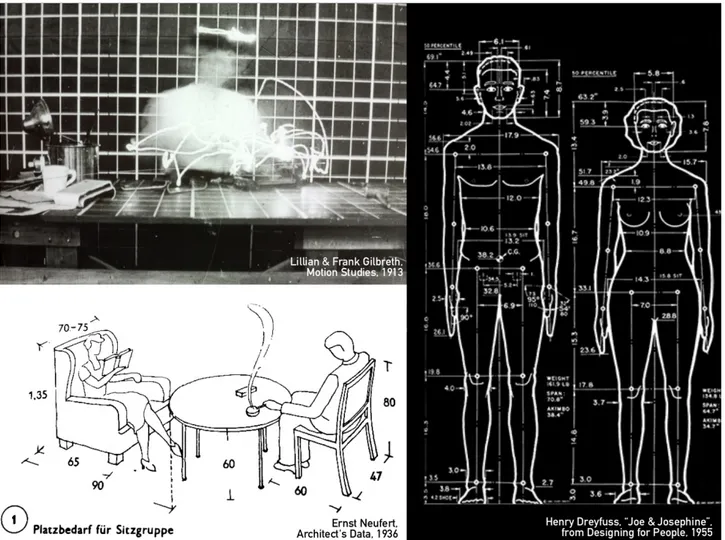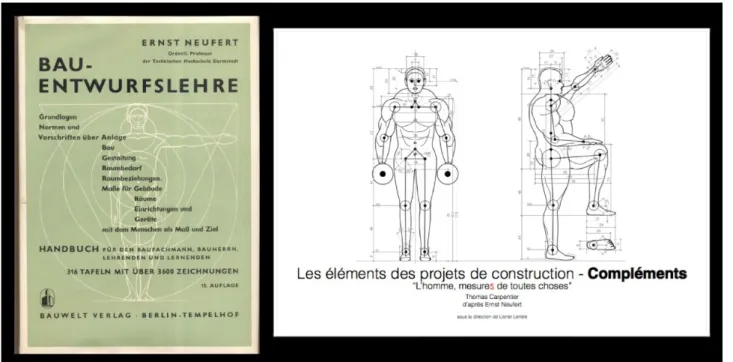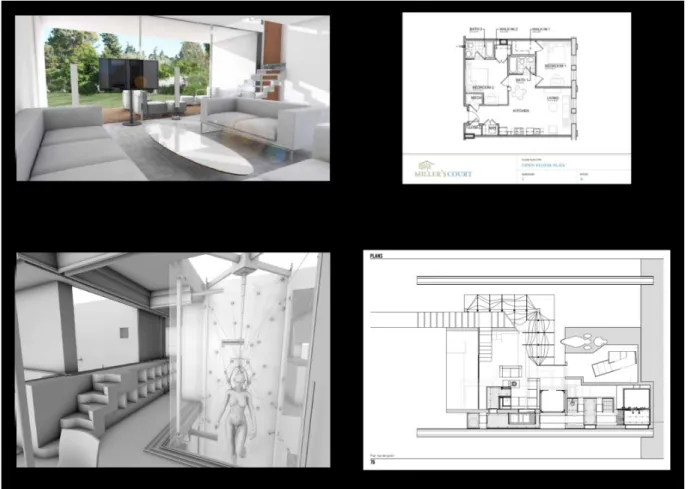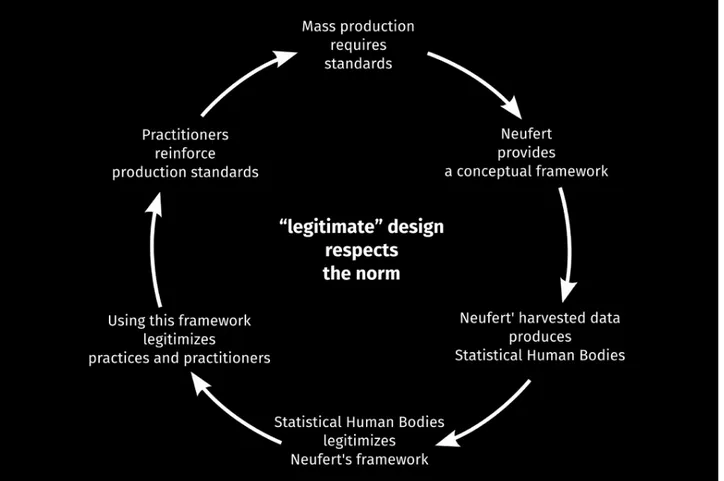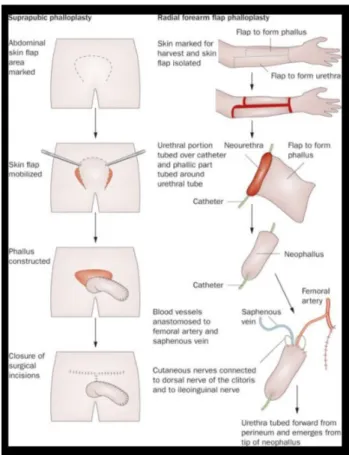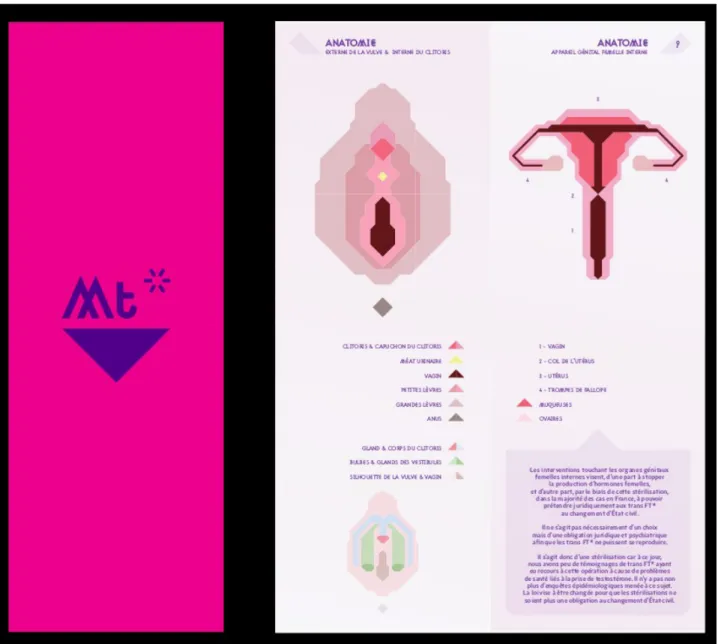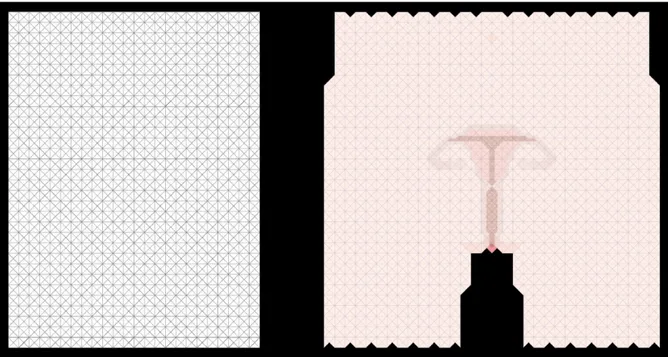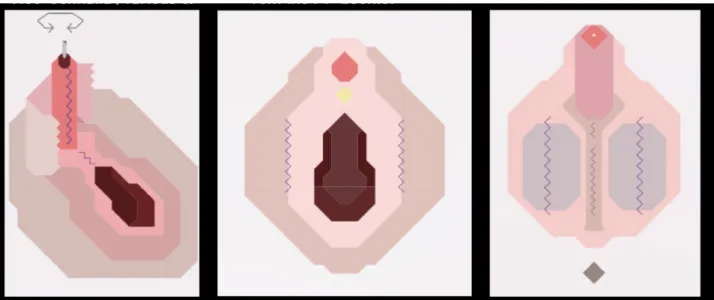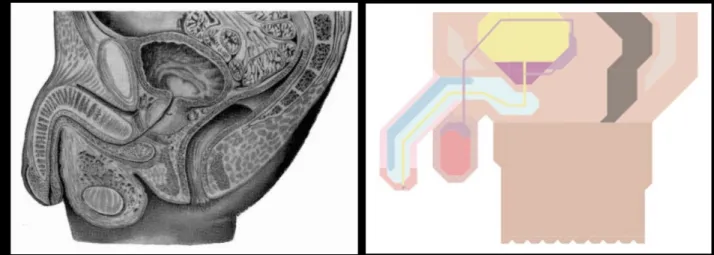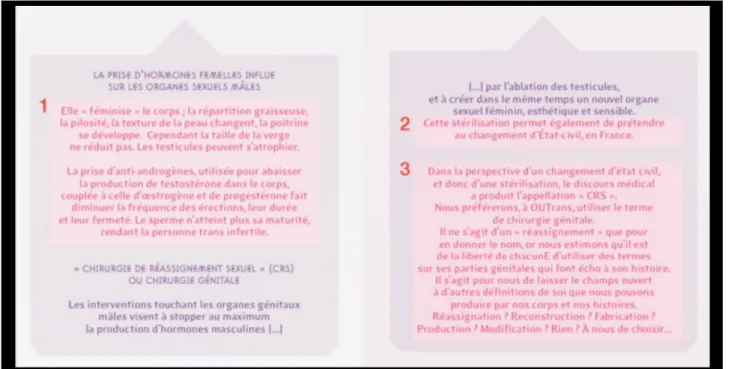HAL Id: hal-01246059
https://hal.archives-ouvertes.fr/hal-01246059
Submitted on 24 Jan 2016
HAL is a multi-disciplinary open access
archive for the deposit and dissemination of sci-entific research documents, whether they are pub-lished or not. The documents may come from teaching and research institutions in France or abroad, or from public or private research centers.
L’archive ouverte pluridisciplinaire HAL, est destinée au dépôt et à la diffusion de documents scientifiques de niveau recherche, publiés ou non, émanant des établissements d’enseignement et de recherche français ou étrangers, des laboratoires publics ou privés.
Distributed under a Creative Commons Attribution - NonCommercial - ShareAlike| 4.0 International License
Disputing Ergonomics, Deconstructing Users. A Queer
Perspective on Design.
Emeline Brulé, Tiphaine Kazi-Tani
To cite this version:
Emeline Brulé, Tiphaine Kazi-Tani. Disputing Ergonomics, Deconstructing Users. A Queer Perspec-tive on Design.. Design History Society, 2015, San Francisco, United States. �hal-01246059�
Disputing Ergonomics. Deconstructing Users.
A Queer Perspective on Design.
Emeline Brulé, PhD Student, CoDesign Lab, Télécom ParisTech Tiphaine Kazi-Tani, Associate Researcher, Télécom ParisTech
Status: Working paper.
In this paper, we investigate body and user representations in design practices, first through a historical perspective on ergonomics, standards and user-centered design, then through two case studies. The first (by Thomas Carpentier, architect) was built upon queer and crip user representations and questions industrial design and architecture. The second
(byHélène Mourrier, graphic designer), led by an activist agenda, proposes an alternative representation of trans* bodies, through a queer graphic vocabulary. Both were chosen not only for their ability to undermine if not deconstruct models that could be called ‘straight’ following Monique Wittig, but also because they exemplify two distinct methodologies of problematization and production: exploring queer ways of designing and investigating ways of designing (with) queer studies.
We will underline how rationalized models of users such as Taylor’s, the Gilbreths’, Neufert’s and Dreyfuss’ (Fig. 1) fit in the modern project, but also how they contributed to the
quantification, differentiation and the setting of the “normal” bodily pre-requisites to engage with artifacts and spaces. We argue that such a modernist enterprise of human
normalization towards industrial standardization might echo what Gayle Rubin has described as heteronormativity. We will develop here the concept of ‘queer design,’ as a becoming-minor of design.
Fig. 1: pictures from the Gilbreths’, Neufert’s and Dreyfuss’ work.
Engineering users: a modern(ist) project
Following literature (Weber, 1930; Giedieon, 1948; Marchand, 1985; Latour, 1991; Brague, 2015), we propose to briefly sum up modernity as a moral enterprise of transcendance relying on scientific / technic / epistemic operations upon the world. As stated by (Giedieon, 1948), “a line leads from the fourteenth century to the present: Oresme - Descartes - Marey -
Gilbreth: the theologian-philosopher - the mathematician-philosopher - the physiologist - the production engineer.”
At the turn of the XXth century, the emergence of mass production and international large-scale trade involved new modes of organization, production, distribution and consumption, and trade partners soon faced the necessity to harmonize their means of production as well as their production itself.
Humans did not escape this will for standardization: Taylor and the Gilbreths studied worker’s gestures to optimize their every moves, while the household itself began to be
conceptualized as a domestic factory and the wife as a domestic worker.
To define their role in this process of global harmonization of production and inscribe standardization in the modern project towards the rise of the “New Man”, designers and architects began to propose guidelines, describing bodies that could be the basis of standardized shapes and units.
What Foucault named ‘Docile bodies’ are produced through such a process of normalization, by and for the industry. To quote Henry (Dreyfuss, 1955) : “our job is to make Joe and Josephine
compatible with their environment. The process is known as human engineering.”
As described by Foucault , “a 'political anatomy', which was also a 'mechanics of power', was
being born; it defined how one may have a hold over others' bodies, not only so that they may do what one wishes, but so that they may operate as one wishes, with the techniques, the speed and the efficiency that one determines.”
About the definition of queer in this article: if we will use queer in its original sense (Oxford Dictionary), “odd or weird,” it is to be acknowledged that this paper is situated within the broader “queer theory,” i.e. the “stud[y of] the webs of power and discourse that create and
uphold the idea that” “social constructs” are “descriptors of innate types,” (Callis, 2012) and
specifically the gender binary construction.
Case studies
Before presenting our case studies, let’s note that both Mourrier’s and Carpentier’s works are post-graduation projects. Both of them graduated with honors, which indicates that both of them met the highest educational expectations in their discipline.
1. Carpentier: Creeping architecture
As stated by Carpentier, the project was born out of a feeling that something was to be questioned in the current standardization of housing and “accessible architecture.” He aimed to “question the notion of standard in contemporary architecture” and “to reshape its discourses.” (Carpentier, 2015)
He decided to design an “anti Neufert,” an add-on to Architect's data (Fig. 2 & 3), which principles and rules remain acclaimed and taught in numerous schools. Convinced that Neufert had been constructing his architectural principles for and from a stereotypical male body, he would base his own standards on ab-normal bodies.
Fig. 2: Covers of Neufert' Architect Data and Carpentier' Add-on
Fig. 3: Left, Neufert' body model, right, Carpentier's.
Criticizing the modern project: The Architect as Storyteller
Carpentier's first step was to collect unconforming fictional or actual personas, whose particular agency would need a tailored housing solution. He constituted a 7-families card set, with personas sorted as follow: the augmented, the disabled, the out-of-proportions, the self-modified, the perfect, the misbehaved and the eccentric. Carpentier designed tailored rooms or furniture (Fig. 4). He framed Alice in the Ikea Wonderland (Fig. 5), and imagined the interior of the Genie’s lamp (Fig. 6).
He then redesigned iconic buildings from the Neufert's era (Fig. 7), as well as “the Dream Home” for a family of fourteen of his characters (Fig. 8).
Fig. 4: Tailored furniture : a seat for Narcissus, a seat for Dracula. From The Architect's data: Add-on.
Fig. 6: Interior Design for the Genie's lamp. From The Architect's data: Add-on.
Fig. 7: What would happen to the Villa Savoye if David Toole, a dancer born without legs, lived in it ? From The Architect's data: Add-on.
Fig. 8: Designing a “Dream Home” for a “monstruous” family. From The Architect's data: Add-on.
Subverting tools: Playfulness and School Boyish Humor
In their latest version, each design was presented as a serie of boards, assembled as a book and contextualized by a short narrative. On a visual level, it is a direct reappropriation, and even “misuse” of Neufert’s visual vocabulary. As a counterpoint, the textual description suggests a wide variety of activities of, and between, the characters. Some are extracted from their background stories, others are proposed by Carpentier, with what we could call a “school boyish humor:” Jabba the Hutt and Monk engage in sexual intercourse, Paris Hilton wants to show her body to passers-by, Pistorius seems to spend his time running in the stairs, the Borg-Queen has been enslaved by Mrs Arpel to provide and control her house’s
electricity...
Carpentier’s card set became a narrative design tool, a playful toolbox generating weird, odd, in short queer encounters between characters and architecture. It allowed him to expose the performativity of architectural discursive tools (sketchings, 3D modeling, blueprints, etc. See fig. 9) as they “produce the phenomena that [they] regulate and constrain.” (Butler, 1990) His
project—as a branch of Neufert's, just like its title, Architects' data: add-on suggests—
highlights how “user-figures become a tool through which particular design decisions are made” (Kelly & Matthews, 2014).
Reshaping Discourses on Norms and Domesticity
His project operates as a critical reflection of a specific paradigm what we would call “the modern regime of truth”, where most architectural products are standardized and globalized. This is exactly how Neufert’s Architects’ Data operates: because it provides a widely used conceptual framework for architects to use in design —and data to support it, it legitimizes in return practices and practitioners, which apply standards to production, which growth needed these standards, shaping new practices, etc. This circular relationship establishes a moral scale for design evaluation: “legitimate” design respects the norm. (Fig. 10)
Because Carpentier masters some of the performative tools of the architectural regime of truth, he was able to use them to expose its arbitrariness. By uncovering the fictional nature of Neufert’s standards, and by producing a new narrative, he contests the essentialization and naturalization of norms.
Fig. 9: upper line: 3D model and plans from a residential project; lower line: 3D model and plans for the “Monster Family“ home
Fig. 10: Of design and the naturalization of norms.
It also appears that Carpentier mostly met gender studies through practice. Which produced an unexpected approach to domesticity. Far from designing spaces covering the full
spectrum of domestic activities, his architectures mostly serve leisure and narrative
purposes. Instead of picturing nuclear families, he exposes individual or communal lifestyles of cyborg-ish (Haraway, 1991) characters. In short, his reflection upon architecture opens up perspectives on a “‘posthuman domesticity”whereas traditional or moral domestic practices tend to disappear, at the profit of “uses to be invented”.
On a broader scope, when reshaping normative architecture around extravagant characters, Carpentier is both queering (“appropriating a representation for one’s own purposes, forcing it to
signify differently”) and cripping ("reveal(ing) able-bodied assumptions and exclusionary effects”),
“expos(ing) the arbitrary delineation between normal and defective and the negative social
ramifications of attempts to homogenize humanity” (Sandahl, 2003). However, therein lies the
rub: queering and cripping are tools of resistance for oppressed communities. One can therefore question the legitimacy of their use in this context. Should anyone theatricalize people as characters? Should bodies, usually invisibilized by stigma, be “put on a pedestal”,
therefore deprived of their right to manage their own visibility?
De-scripting users and bodies
To give a few elements of answer to these questions, we first need to mention Carpentier’s claim of “tenderness for the monsters,” for the characters he worked with. As stated by Haraway (1991), “monsters have always defined the limits of community in Western
imaginations”—here community is redefined as encompassing them. Carpentier’s project
wasn’t so much about proposing or producing a more inclusive architecture, as sensitizing himself and others to the necessary care for otherness, actual users and the ways they relate, in the design process.
Carpentier’s process of deconstruction doesn’t produce standards, while allowing the proliferation of scripts. It exposes that inhabiting practices, understood as particular habits shaping available spaces, are enacted in / by architectural propositions. The presence of “anomal” (Canguilhem, 1991 [1966]) characters, in the words of Canguilhem - that is to say escaping customs and habitus - incit to rethink the moral agenda of modern architecture (centered around the “bourgeois family” (Clarisse, 2004)) and make visible the relational agency of bodies, design and the natural world.
2. Mourrier: Designing (with) queer theory
Our second case-study is Hélène Mourrier’s “Trans/Formations” booklets, designed for OUTrans, as she was completing her postgraduate degree in Scientific Illustration at École Supérieure des Arts et Industries Graphiques (ESAIG). This degree is appointed by the Pitié-Salpêtrière hospital and partly supervised by practitioners who guarantee the acquisition of specific and valid scientific knowledge. The terminal project must be achieved in an actual professional context to fulfill the school’s requirements for graduation.
2.1. Project motivations
As Hélène Mourrier was completing her 1st-year internship in a transgender support
organization, she realized that “all the discourses, all the scientific and medical knowledge about
transidentity were voiced by the medical profession.” (Fig. 11) “[She] did not have to look any further: [her] degree project was to focus on the trans genital surgical procedures.” (Mourrier,
2014) During the second year of the postgraduate course, Mourrier chose to work with and for OUTrans: a self-directed support organisation actively involved in the field of trans
healthcare. The organization works mainly about trans healthcare issues. Hélène Mourrier joined in 2010, and offered the organization to design information booklets about gender-reassignment surgical procedures intended for trans people (Fig. 12).
Fig. 11: Phalloplasty - ‘Gender Reassignment Surgery, an Overview’, in Urology, (8), 2011.
2.2. Reclaiming design methods: the Activist as Designer The design methodological matrix as a critical tool
Design education in France mostly relies on officially appointed reference documents precisely setting a matrix for design practice and defining goals, skills, ethics and methods. (Ministère de l’Enseignement Supérieur et de la Recherche, 1996a, 1996b, 2012)
Mourrier followed a simple though operating methodology based on this matrix she nurtured with her OUTrans activist’s position. This lead her to develop a graphic system supporting her political, moral, ethical agenda while meeting the educational expectations. Her graphic system is based on a geometric modular grid where the core module is an
inverted isosceles right triangle (Fig. 13), a shape that refers to the markings of homosexuals in concentration camps (Fig. 14), which reversal is a literal interpretation of the queer use of inversion and re-appropriation of the stigma, as already efficiently used by AIDS Coalition To
Unleash Power (ACT-UP) since the late 80’s.
contrast slightly with pale yellow, green and blue, brings back the presence of the flesh (Fig. 16). Shades and contrasts are not used to mimic volume, as in conventional painting
techniques, but rather suggest the body parts’ non-homogenous pigmentation, especially genitalia’s. This extensive palette of pink is a graphic attempt to re-sexualize the transitioning bodies, from which any reference to any erotic activity has been eventually discarded as they were turned into a biomedical subject. As Mourrier bluntly states, “the trans bodies are also
bodies for fucking”: “the choice of pastel colors is a transcription of the sensitive and erogenous value of the sexual areas in question.” (Mourrier, 2014)
Fig. 12: MT* booklet, front cover / FT* booklet, excerpt from inner pages, Hélène Mourrier / OUTrans 2011-2013.
Fig. 13: From a modular grid based on duplicated triangles...to a coronal plane of the pelvis. By Hélène Mourrier 2011-2013.
Fig. 14: Inverting the Stigma: From the nazi marking system to homosexual activism.
Fig. 16: Resexualizing medical bodies. ‘Neo-Genitalia’, various excerpts from the FT* booklet.
Challenging hegemonic discourses and representations
The graphic language of Hélène Mourrier has made visible the trans activist framework, influenced by concepts coined by Butler or Haraway, through an artificial system of representations, detached from any canonical mimesis. It produces mutating shapes parodying the standardized codes of visual information, de-naturalising (Butler, 1990) the biomedical sciences representations. “The anatomical parts [composing and recomposing
themselves] at will” are playing down surgical procedures themselves .
Mourrier offers visual tools for permanent construction to transitioning bodies, bodies evading the figures of the ideal gendered body; a sort of graphic tangram “without genesis, but
[...] without end” (Haraway, 1991).
It is notable that the graphic system designed by Hélène Mourrier does not consist in highjacking or reappropriation.
By addressing her ethical responsibility as a designer from her activist perspective, Mourrier has chosen to refute what is refutable, if not ‘repudiable’ here: namely the representational standards (the Canon of her discipline, see Fig. 17), which say nothing about the truth of the biomedical surgery, but set a normative and naturalizing body-representation system which is hereby challenged by the queer/trans bodies-in-progress. We argue that Mourrier actually deterritorialized her discipline and reterritorialized it in her trans-activist context. She disrupted the set of medical power relations (a absolute and hegemonic biomedical knowledge) and actualized them in a confrontation to political, legal, linguistic, visual contents. These booklets are somehow trans in their own way: a hybrid discourse, without hierarchy, without separation between disciplines and knowledge, “ a true monster,” (Foucault
1970 : 61) a “parodic proliferation ” of statements “ [depriving] hegemonic culture and its critics of
the claim to naturalized or essentialist gender identities.”(Butler 1990 : 176)
As such, we argue that Mourrier's project can be understood as an assemblage:
“a multiplicity that contains a large number of heterogeneous terms and that establishes
links, relationships with each other, through different ages, genders, reigns, natures. Thus the only unit of the assemblage is to co-operate: it is a symbiosis, a “sympathy”. What matters are never filiations, but alliances and alloys.”
Through the alliances and alloys of a heterogeneous set of signs and discourses, OUTrans and Mourrier have been producing “strategies of relations of forces supporting, and supported
by, types of knowledge ” (Foucault, 1980: 196), i.e.: a queer apparatus [dispositif] engaging in a
relation of forces with a normative apparatus.
Systematically engaging design tools in a critical perspective, Mourrier opens a breach for a “teratology”, in the words of Foucault, of legal and biomedical knowledge. (Fig. 18)
Fig. 17: Refuting the Canon. Left: Male pelvis, sagittal plane, Johannes Sobotta, 1904 . Right: Male pelvis, sagittal plane, Hélène Mourrier, 2011
Fig. 18: The point 1 is a technical description of the effects of antiandrogens (medical discourse). The point 2 is a succint memo about the required conditions for a change of civil registration for trans people (legal
discourse). The point 3 is a critical / theoretical statement addressing the articulation between science, laws and self-representation (political discourse). This illustrates how a “true monster” in Foucault' sense was born from this design project. Excerpt from OUTrans Booklets, 2011-2013.
How we might live: A Queer Utopia for Design?
1. Towards a Queer Design Matrix ?
Could a queer matrix be theorized for design? Should a queer design matrix be established as a method, or a posture? We argue that, instead, queer theory offers a radical approach to design and its practitioners.
Mourrier and Carpentier propose an anti-authoritarian approach to design. They encourage design to produce situated apparatuses, that may or may not be incompatible with mass production. Their projects highlight methods to engage design in a reflective and
performative critique that embraces a queer framework following two different perspectives.
2. Design methods and tools: queer critique, queer empowering
While Carpentier is engaging in a performative critique of design as a discursive apparatus of normalization, Mourrier is trying to rouse graphic design and its methodological matrix from being an agent of essentialization.
in hegemonic discursive apparatuses (i.e. school, medical profession, etc.), 2/ unveiling the performative property of any discourse of truth, 3/ producing operating resistances (displacements of signifying elements, de-naturalization of hegemonic discourses, production of new discourses on a « counter-performative » mode).
In Architect’s Data: Add-On, Carpentier gathers a vast range of hegemonic representational tools (from technical diagrams to computer-aided design sketches) to dramatize the signifying representations and discourses of his profession (Butler, 1990), and operate a critical parody, a drag of architecture as a regime of truth over bodies and uses.
As for Mourrier, she identifies her practice as a realm of “rigor, faithful to the truth of science,
ambitioning to participate in the understanding of a system or scientific data”. She keeps in mind
that graphic design is technically and historically linked to the production of any regime of truth, and therefore any regime of power. A strong ethic of the care has been leading Mourrier to relate “her attachment to a gentle approach to bodies, experiences, speeches and
their modes of existence” to “her working and reflective attitudes, and “her methodological and creative choices” (Kazi-Tani, 2015).
We argue that, this care for her practice and its potential power and responsiblity has helped her displace graphic design from a hegemonic discursive regime to a “minor” one, offering the trans community a counter-apparatus of subjectivation.
3. A Becoming-Minor of design
The most decisive quality of Mourrier and Carpentier’s work is an ability to capture and recondition the potency of a technical, aesthetic and semantic apparatus, usually dependant of an hegemonic power.
Furthermore, this reflective, ethical and moral capacity is a fundamental part of what we call the “design matrix”. We believe it is important to underline that Carpentier and Mourrier’s project, somehow, precisely conform to the educative institution expectations, which in return validates their design approach. Thus, the critical dimension of each of these projects is neither transgressive, nor subversive, but quite literally “radical” (from the latin radix, “root”), as it is situated at the roots of the historical “social agency” of design.
The strength of Carpentier and Mourrier’s propositions is to highlight “the effects of power
which are linked with knowledge, competence, and qualification: struggles against the privileges of knowledge. But they are also an opposition against secrecy, deformation, and
that this way of designing, lying in the dominant matrix of design, nevertheless questions “the way in which knowledge circulates and functions, its relations to power. In short, the ‘régime du
savoir’.” (1982: 781.)
This re-conditioning operates on a “minor” mode, taking the shape of a “design drag” in Carpentier’s project, and of a furtive displacement, if not a decentring, in Mourrier’s. Through exhibitions and publications, they join the mainstream apparatus of
Power/Knowledge (Foucault, 1980), but not without having them experienced “the gap that
separates” this queer approach of design “from this or that axiom constituting a redundant majority” (Deleuze & Guattari, 1987: 469).
We precedently pointed out that, Carpentier reclaimed a critical posture towards the discursive tools of his profession. In Mourrier’s case, no critical position is engaged in a performative mode: still, if she doesn’t call her practice “critical”, she throws into crisis (i.e. a critical state) the hegemonic mode of graphic design practice with all of her professional tools.
We argue that this never-named-displacement may constitute a “Becoming-Minor” (Deleuze & Guattari, 1987; Eribon, 2003) of design, as it “[does not aim] at creating ‘a set
defined in relation to the majority,’ but to produce a movement that may also affect what the minority departs and deflects, that may be driven and amended by the Becoming” (Eribon, 2003).
Furthermore, as stated in (Deleuze and Guattari, 1986), “minor no longer designates specific literatures but the revolutionary conditions for every literature within the heart of what is called great (or established) literature.”
This is particularly the case in Mourrier's project: every time her booklets are produced, read or distributed, they undermine the larger assemblage they fit in, they empower and visibilize trans* people. Because it exists not only as a project or a set of hypothesis, but became a tool for a community, it positions queerness as “revolutionary conditions” inside the graphic design community.
In a moment when hegemonic expressions of design seem to “consider all minor variations as
gaps integrable in homogeneous and constant sub-systems, themselves derivable from the major or standard system” (Sibertin-Blanc, 2003 [our translation]), it seems fertile to support modes of
References
Beder, S., 2004. 'Consumerism – an Historical Perspective'. Pacific Ecologist9, Spring, pp. 42-48.
Benjamin, W., 1968. The Work of Art in the Age of Mechanical Reproduction, in: Arendt, H. (Ed.), Zohn, H. (Tran.), Illuminations: Essays and Reflections. Schocken Books.
Bernays, E.L., 1928. Propaganda. Horace Liveright, New York.
Brague, R., 2015. Le Règne de l’homme: Genèse et échec du projet moderne. Gallimard, Paris.
Briggs, A., & Burke, P., 2009. Social History of the Media: From Gutenberg to the Internet
Butler, J., 1990. Gender Trouble. Feminism and the Subversion of Identity. Boston: Routledge.
Callis, A. S. 2009. Playing with Butler and Foucault: Bisexuality and Queer Theory.Journal of Bisexuality,
9(3-4), 213–233.
Canguilhem, G., 1991 [1966]. The Normal and the Pathological. Zone Books, New York.
Carpentier, T., 2011. Les Éléments des projets de construction : Compléments (Architect’s Data: Add-On). Unpublished Masters Thesis. Paris: École Spéciale d’Architecture.
Carpentier, T., 2015. Interview with Thomas Carpentier by Emeline Brulé and Tiphaine Kazi-Tani, June the 6th 2015.
Chen, M., 1998. “I am an Animal!”: Lexical Reappropriation, Performativity, and Queer. Engendering
Communication: proceedings of the Fifth Berkeley Women and Language Conference. Hall, K. et al, ed.,
Berkeley: IGALA, pp. 128-140.
Clarisse, C., 2004. Cuisine : recettes d'architecture. Besançon: Éditions de l’Imprimeur.
Deleuze, G., 1995. Negotiations, 1972-1990. New-York: Columbia University Press.
Deleuze, G., Guattari, F., 1987. A Thousand Plateaus: Capitalism and Schizophrenia 2. University of Minnesota Press, Minneapolis.
Deleuze, G., Guattari, F., 1986. Kafka. Toward a Minor Literature. Translation by Dana Polan. University of Minnesota Press.
Dorrestijn, S., & Verbeek, P.-P., 2013. Technology, Wellbeing, and Freedom: The Legacy of Utopian Design.
International Journal of Design, 7(3), 45–56.
Dreyfuss, H., 1955. Designing For People.New York: Simon & Schuster.
Dunne & Raby, 1999. Hertzian Tales.London: CRD Research, Royal College of Art.
Eribon, D., 2003. Gilles Deleuze. Dictionnaire des cultures gays et lesbiennes. Retrieved from <http://didiereribon.blogspot.fr/2007/09/sur-gilles-deleuze.html>.
Ewen, S. 1976. Captains of Consciousness: Advertising and the Social Roots of the Consumer Culture(New York: McGraw-Hill, 1976), pp. 70, 108.
Fallman, D., 2008. The Interaction Design Research Triangle of Design Practice, Design Studies, and Design Exploration. Design Issues 24, 4–18.
Fook, J., White, S., Gardner, F., others, 2006. Critical Reflection: a Review of Contemporary Literature and Understandings. Critical Reflection in Health and Social Care3–20.
Foucault, M., 1970. The Order of Discourse. In R. Young, ed. Untying the Text: A Post-Structuralist Reader. Boston: Routledge, pp. 48-78.
Foucault, M., 1995 [1977]. Docile Bodies. Discipline & Punish. The Birth of Prison. New-York: Vintage Books, pp. 135-169.
Foucault, M., 1976. The Political Function of the Intellectual. Radical Philosophy, no. 17 (Summer 1977), pp. 12-14
Foucault, M., 1980. The Confession of the Flesh. In C. Gordon, ed., Power/Knowledge: Selected Interviews
and Other Writings. 1972-1977. New-York: Pantheon Books, pp. 194-228.
Foucault, M., 1982. The Subject and Power. Critical Inquiry, 8(4), pp.777–795.
Giedieon, S., 1970 [1948]. Mechanization Takes Command. New-York: Oxford University Press.
Haraway, D., 1991. A Cyborg Manifesto. Retrieved from
<http://people.oregonstate.edu/~vanlondp/wgss320/articles/haraway-cyborg-manifesto.pdf> (accessed 7.21.15).
Horkheimer, M., Adorno, T.W., 2002. Dialectic of enlightenment: philosophical fragments, Cultural memory in
the present.Stanford University Press, Stanford, Calif.
Kazi-Tani, T., 2015. Queer Graphics. The Critical Work of Helene Mourrier: Designing Counter-Power, Shaping Counter-Knowledge. Presented at ENVELOPE 2015: Designing Critical Messages, Feb 2015, Plymouth, United Kingdom.
Kazi-Tani, T. et al., 2015. Good People Behave, Bad People Design. Misbehaving as a Methodological Framework for Design and Design Education. To be presented atIASDR 2015 - Interplay, 2-5 november
2015, Brisbane, Australia.
Keane, W,. 2002. Sincerity, "Modernity," and the Protestants.
Kelly, J., & Matthews, B. 2014. Displacing use: Exploring alternative relationships in a human-centred design process. Design Studies, 35(4), 353–373.
Lambert, L., 2012. A Subversive Approach to the Ideal Normatized Body. The Funambulist, Retrieved from < http://thefunambulist.net/2012/04/29/architectural-theories-a-subversive-approach-to-the-ideal-normatized-body/> (accessed 7.21.15).
Lantenois, A., 2010. Le Vertige du funambule. Le Design graphique entre économie et morale. Paris: B42.
Latour, B., 1993 [1991]. We have never been modern. Harvard University Press.
Lupton, E., 2014. Beautiful Users. Designing for People. Princeton: Princeton Architectural Press.
Marchand, R. 1985. Advertising the American Dream: Making way for modernity, 1920-1940. Berkeley: University of California Press.
Ministère de l’Enseignement Supérieur et de la Recherche, 1996a. Référentiel du Brevet de Technicien
Supérieur option Communication Visuelle.Retrieved from
<a.appliques.creteil.free.fr/telechargements/ReferentielBTScvGraph.pdf> (accessed 7.21.15).
Ministère de l’Enseignement Supérieur et de la Recherche, 1996b. Référentiel du Diplôme Supérieur d’Arts
Appliqués option Illustration Médicale et Scientifique.Retrieved from
<http://designetartsappliques.fr/sites/default/files/R%C3%A9f%C3%A9rentiel%20DSAA%20Illustration %20m%C3%A9dicale%20et%20scientifique.pdf> (accessed 7.21.15).
Ministère de l’Enseignement Supérieur et de la Recherche, 2012a. Référentiel du Brevet de Technicien
Supérieur option Design Graphique. Retrieved from
<https://www.sup.adc.education.fr/btslst/referentiel/BTS_DesignGraphique.pdf> (accessed 7.21.15).
Ministère de l’Enseignement Supérieur et de la Recherche, 2012b. Référentiel du Diplôme Supérieur d’Arts
Appliqués option Design.Retrieved from
<https://www.sup.adc.education.fr/btslst/referentiel/DSAA_design.pdf> (accessed 7.21.15).
Mollon, M. & Gentès, A., 2014. The Rhetoric of Design for Debate: triggering conversation with an “uncanny enough” artefact (pp. 1–13). Presented at the Proceedings of the Design Research Society International Consortium (DRS), Umeå, Sweden.
Mourrier, H., 2013. Du Coeur à l’ouvrage : l’illustration scientifique et médicale. Etapes, (214), pp. 34-47.
Mourrier, H., 2014. Interview with Hélène Mourrier by Tiphaine Kazi-Tani, September the 24th 2014.
Mozère, L., 2005. Devenir-femme chez Deleuze et Guattari: Quelques éléments de présentation. Cahiers
du Genre38, 43.
Neufert, E., (1970). Architect’s’ Data, First English Edition. London: Staples Press.
Norman, D. A., & Draper, S. W. (1986). User Centered System Design; New Perspectives on Human-Computer
Interaction. Hillsdale, NJ, USA: L. Erlbaum Associates Inc.
Rodrigue, J.-P., 2013. Historical Geography of Transportation: The Emergence of Mechanized Systems.
<https://people.hofstra.edu/geotrans/eng/ch2en/conc2en/ch2c1en.html> (accessed 7.21.15).
Sandahl, C. (2003). Queering the crip or cripping the queer?: Intersections of queer and crip identities in solo autobiographical performance. GLQ: A Journal of Lesbian and Gay Studies, 9(1), 25–56.
Sibertin-Blanc, G., 2003. Pour une littérature mineure : Un cas d’analyse pour une théorie des normes chez Deleuze. Retrieved from <
http://stl.recherche.univ-lille3.fr/seminaires/philosophie/macherey/Macherey20022003/Sibertin.html> (accessed 7.21.15).
Spigel, L., 2005. Designing the Smart House Posthuman Domesticity and Conspicuous Production.
European Journal of Cultural Studies, 8, 403–426.
Wittig, M., 1992. The Straight Mind & Other Essays. Boston: Beacon Press.
Weber, M., 1930. The Protestant Ethic and the Spirit of Capitalism. London: Unwin Hyman.
Zöllner, F. (2015). Anthropomorphism: From Vitruvius to Neufert, from Human Measurement to the Module of Fascism. In K. Wagner & J. Cepl (Eds.), Images of the Body in Architecture: Anthropology and Built Space. Berlin: Ernst Wasmuth Verlag.
